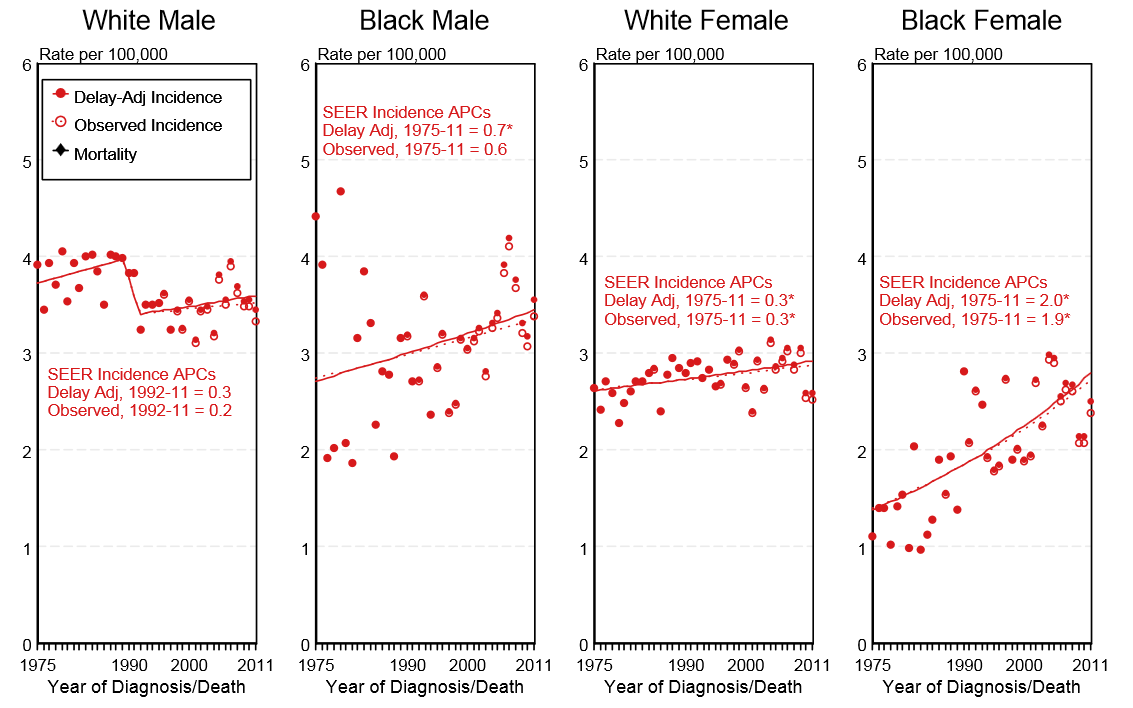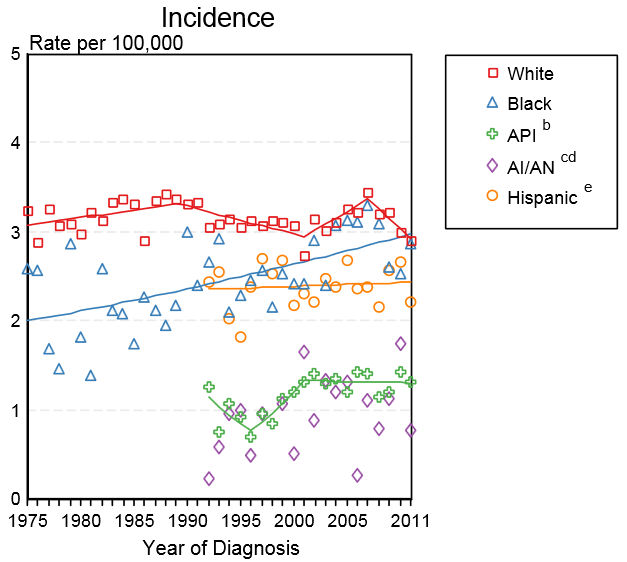Hodgkin's lymphoma epidemiology and demographics
|
Hodgkin's lymphoma Microchapters |
|
Diagnosis |
|---|
|
Treatment |
|
Case Studies |
|
Hodgkin's lymphoma epidemiology and demographics On the Web |
|
American Roentgen Ray Society Images of Hodgkin's lymphoma epidemiology and demographics |
|
Hodgkin's lymphoma epidemiology and demographics in the news |
|
Risk calculators and risk factors for Hodgkin's lymphoma epidemiology and demographics |
Editor-In-Chief: C. Michael Gibson, M.S., M.D. [1]; Associate Editor(s)-in-Chief: Rim Halaby, M.D. [2], Sowminya Arikapudi, M.B,B.S. [3]
Overview
Hodgkin's lymphoma has a bimodal age distribution that differs geographically and ethnically in industrialized countries; the early peak occurs in the middle-to-late 20s and the second peak after age 50 years. In developing countries, the early peak occurs before adolescence.[1] In 2015, the incidence of Hodgkins lymphoma was estimated to be 3 cases per 100,000 individuals in the United States.[1] The incidence of Hodgkin's lymphoma is higher among patients with HIV/AIDS; however, in contrast to many other lymphomas associated with HIV infection, Hodgkin's lymphoma occurs most commonly in patients who do not have severe immunosupression.[2]
Epidemiology and Demographics
Prevalence
- In the United States, the age-adjusted prevalence of Hodgkin's lymphoma is 35 per 100,000 in 2011.[3]
Incidence
- In 2015, the incidence of Hodgkins lymphoma was estimated to be 3 cases per 100,000 individuals in the United States.[1]
Age
- Hodgkin's lymphoma has a bimodal age distribution that differs geographically and ethnically in industrialized countries; the early peak occurs in the middle-to-late 20s and the second peak after age 50 years. In developing countries, the early peak occurs before adolescence.[1]
- The incidence of Hodgkin's lymphoma is estimated to be 2.9 cases per 100,000 adolescents among ages 15 to 19 years in the United States.
- The incidence of Hodgkin's lymphoma is estimated to be 0.9 cases per 100,000 children among ages 10 to 14 years in the United States.
- The incidence of Hodgkin's lymphoma is estimated to be 0.3 cases per 100,000 children among ages 5 to 9 years in the United States.
- The incidence of Hodgkin's lymphoma is estimated to be 0.09 cases per 100,000 children among 4 years of age in the United States.
- While the overall age-adjusted incidence of Hodgkin's lymphoma in the United States between 2007 and 2011 is 2.7 per 100,000, the age-adjusted incidence of Hodgkin's lymphoma by age category is:[3]
- Between 20 and 29 years: 4.1-4,5 per 100,000
- Under 65 years: 2.5 per 100,000
- 65 and over: 4.2 per 100,000
Gender
- In children <5 year, males are more commonly affected with Hodgkin's lymphoma than females. The male to female ratio is approximately 5.3.[1]
- In children aged 15 to 19 year, females are more commonly affected with Hodgkin's lymphoma than males. The male to female ratio is approximately 0.8.
- In the United States, the age-adjusted prevalence of Hodgkin's lymphoma by gender in 2011 is:[3]
- In males: 37.2 per 100,000
- In females: 33.1 per 100,000
- In the United States, the age-adjusted incidence of Hodgkin's lymphoma by gender on 2011 is:[3]
- In males: 3.11 per 100,000 persons
- In females: 2.34 per 100,000 persons
- In the United States, the delay-adjusted incidence of Hodgkin's lymphoma by gender in 2011 is:[3]
- In males: 3.22 per 100,000 persons
- In females: 2.42 per 100,000 persons
Shown below is an image depicting the delay-adjusted incidence and observed incidence of Hodgkin's lymphoma by gender and race in the United States between 1975 and 2011. These graphs are adapted from SEER: The Surveillance, Epidemiology, and End Results Program of the National Cancer Institute.[3]
Race
- Shown below is a table depicting the age-adjusted prevalence of Hodgkin's lymphoma by race in 2011 in the United States.[3]
| All Races | White | Black | Asian/Pacific Islander | Hispanic | |
| Age-adjusted prevalence | 35 per 100,000 | 40 per 100,000 | 32.1 per 100,000 | 12.6 per 100,000 | 23.6 per 100,000 |
Shown below is an image depicting the incidence of Hodgkin's lymphoma by race in the United States between 1975 and 2011.[3]
API: Asian/Pacific Islander; AI/AN: American Indian/ Alaska Native
References
- ↑ 1.0 1.1 1.2 1.3 1.4 "National Caner Institute Childhood Hodgkin Lymphoma Treatment".
- ↑ Biggar RJ, Jaffe ES, Goedert JJ, Chaturvedi A, Pfeiffer R, Engels EA (2006). "Hodgkin lymphoma and immunodeficiency in persons with HIV/AIDS". Blood. 108 (12): 3786–91. doi:10.1182/blood-2006-05-024109. PMID 16917006.
- ↑ 3.0 3.1 3.2 3.3 3.4 3.5 3.6 3.7 Howlader N, Noone AM, Krapcho M, Garshell J, Miller D, Altekruse SF, Kosary CL, Yu M, Ruhl J, Tatalovich Z,Mariotto A, Lewis DR, Chen HS, Feuer EJ, Cronin KA (eds). SEER Cancer Statistics Review, 1975-2011, National Cancer Institute. Bethesda, MD, http://seer.cancer.gov/csr/1975_2011/, based on November 2013 SEER data submission, posted to the SEER web site, April 2014.

